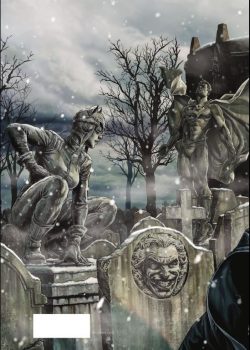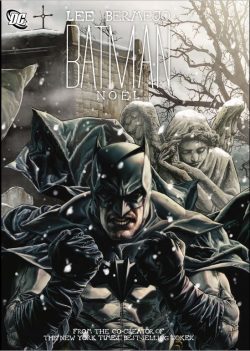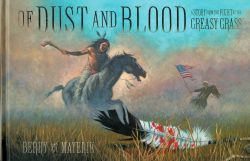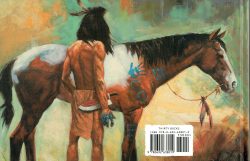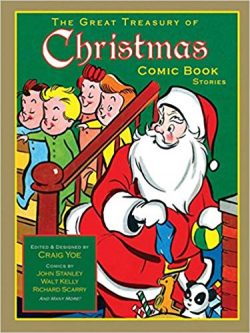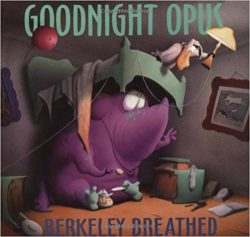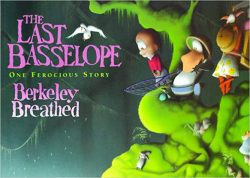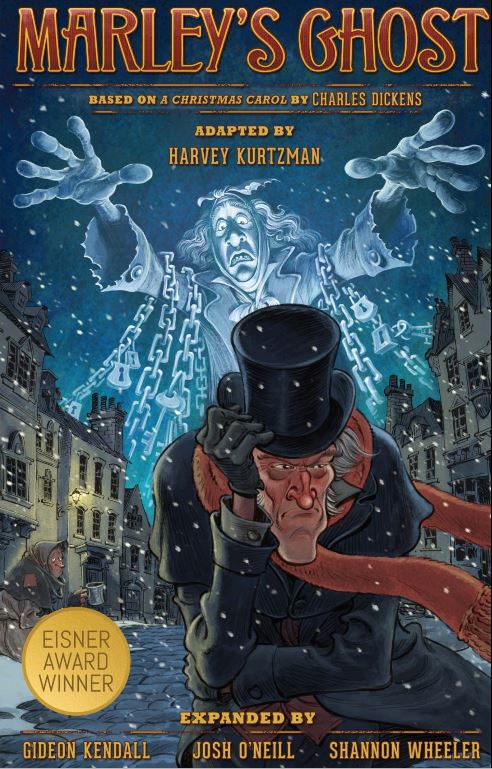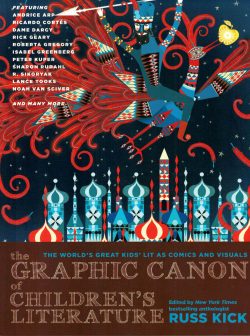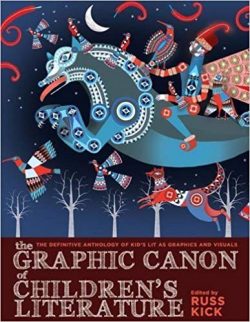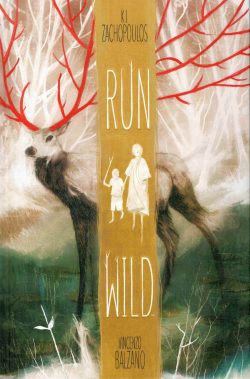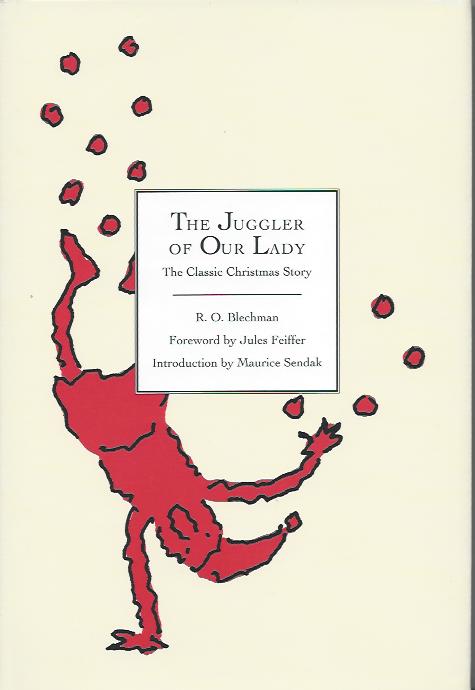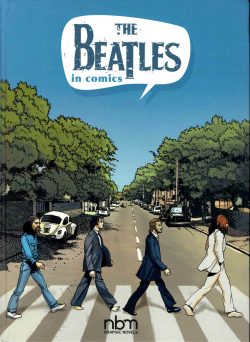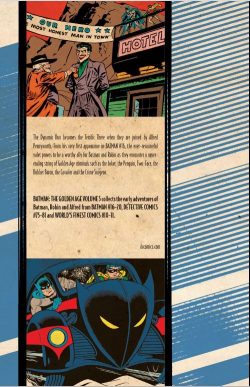
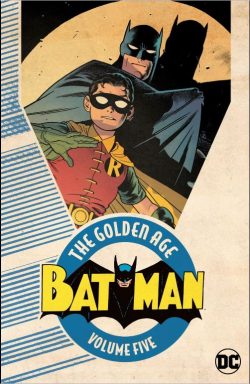
By Bill Finger, Don Cameron, Ruth “Bunny†Lyon Kaufman, Horace L. Gold, Joseph Greene, Joe Samachson, Bob Kane, Jerry Robinson, George Roussos, Dick Sprang, Jack Burnley, Ray Burnley, Fred Ray, Norman Fallon & various (DC Comics)
ISBN: 978-1-4012-8461-9 (TPB)
Win’s Christmas Gift Recommendation: Timely and Evergreen Family Adventure… 10/10
Debuting a year after Superman, “The Bat-Man†(and latterly Robin, the Boy Wonder) confirmed DC/National Comics as the market frontrunner and conceptual leader of the burgeoning comicbook industry.
Having established the parameters of the metahuman with their Man of Steel, the physical mortal perfection and dashing derring-do of the strictly-human Dynamic Duo rapidly became the swashbuckling benchmark by which all other four-colour crime-busters were judged.
Batman: The Golden Age is a series of paperback feasts (there are also weightier, pricier, more capacious hardback Omnibus editions available, and digital iterations too) re-presenting the Dark Knight’s earliest exploits.
Presented in original publishing release order, the tomes trace the character’s growth into the icon who would inspire so many and develop the resilience needed to survive the stifling cultural vicissitudes that coming decades would inflict upon him and his partner, Robin.
Re-presenting a glorious and astounding treasure-trove of cape-&-cowl classics and iconic covers from Detective Comics #75-81, Batman #16-20 plus contemporary companion tales from World’s Finest Comics #10-11: this book covers groundbreaking escapades from April/May 1943 to December/January 1944: as the Dynamic Duo continually develop and storm ahead of all competition.
I’m certain it’s no coincidence that many of these Golden Age treasures are also some of the best and most reprinted tales in the Batman canon. With chief writers Bill Finger and Don Cameron at a peak of creativity and production, everybody on the Home Front was keen to do their bit – even if that was simply making kids of all ages forget their troubles for a brief while. These tales were crafted just as the dark tide was turning and an odour of hopeful optimism was creeping into the escapist, crime-busting yarns – and especially the stunning covers – seen here in the work of Jerry Robinson, George Roussos, Bob Kane Jack Burnley, Dick Sprang, Fred Ray and Stan Kaye…
The supplemental writers all pushed the boundaries of the adventure medium whilst graphic genius Sprang began to slowly supersede Kane and Burnley: making the feature uniquely his own while keeping the Dynamic Duo at the forefront of the vast army of superhero successes.
War always stimulates creativity and advancement and these sublime adventures of Batman and Robin more than prove that axiom as the growing band of creators responsible for producing myriad adventures of the Dark Knight hit an artistic peak which only stellar stable-mate Superman and Fawcett’s Captain Marvel were able to equal or even approach.
with
The compelling dramas open with the landmark Batman #16 (cover-dated April/May 1943) and one of three tales by Cameron. ‘The Joker Reforms!’ (Kane, Robinson & Roussos art) sees the Clown Prince suffer a blow to the head and enjoy a complete personality shift… but not for long…, after which Ruth “Bunny Lyons†Kaufman scripted a bold and fascinating Black Market milk caper in ‘The Grade A Crimes!’ for Ray & Jack Burney to dynamically delineate.
‘The Adventure of the Branded Tree’ (Cameron and the Burnleys) has the Gotham Gangbusters heading to lumberjack country for a vacation to become embroiled in big city banditry before the issue wraps up with hilarious thriller-comedy ‘Here Comes Alfred!’ (Cameron, Kane, Robinson & Roussos) which foists a rotund, unwelcome and staggeringly faux-English manservant upon the Masked Manhunters to finally complete the classic core cast of the series in a brilliantly fast-paced spy-drama with loads of laughs and buckets of tension…
Detective Comics #75 (May 1943) introduces a new aristocrat of crime in pompous popinjay ‘The Robber Baron!’ (Cameron, Jack Burnley & Roussos) before the Joker resurfaces in #76 to ‘Slay ’em With Flowers’: a graphic chiller by Horace L. Gold, Robinson & Roussos.
Next up is Batman #17 which opens with the gloriously human story of B. Boswell Brown: a lonely, self-important old man who claims to be ‘The Batman’s Biographer!’ Unfortunately, ruthless robber The Conjurer gives the claim far more credence than most in a tense thriller by Cameron, Kane, Robinson & Roussos…
Counterbalancing the dark whimsy is ‘The Penguin Goes A-Hunting’ (Cameron, Jack & Ray Burnley): a wild romp wherein the Perfidious Popinjay undertakes a hubris-fuelled crime-spree after being left off a “Batman’s Most Dangerous Foes†list.
The same creative team concocted ‘Rogues Pageant!’ wherein murderous thieves in Western city Santo Pablo inexplicably disrupt the towns historical Anniversary celebrations after which Joe Greene, Kane & Robinson detail the Dynamic Duo’s brutal battle with a deadly gang of maritime marauders in the appealing ‘Adventure of the Vitamin Vandals!’
The creation of Superman propelled National Comics to the forefront of their fledgling industry and in 1939 the company was licensed to produce a commemorative comicbook celebrating the start of the New York World’s Fair, with the Man of Tomorrow prominently featured among the four-colour stars of the appropriately titled New York World’s Fair Comics.
A year later, following the birth of Batman and Robin, National combined Dark Knight, Boy Wonder and Action Ace on the cover of the follow-up New York World’s Fair 1940.The spectacular 96-page anthology was a tremendous success and the oversized bonanza format was established, becoming Spring 1941’s World’s Best Comics#1, before finally settling on the now-legendary title World’s Finest Comics from the second issue, beginning a stellar 45-year run which only ended as part of the massive clear-out and de-cluttering exercise that was Crisis on Infinite Earths.
Until 1954 and the swingeing axe-blows of rising print costs, the only place Superman and Batman ever met was on the stunning covers by the likes of Burnley, Fred Ray and others. Between those sturdy card covers, the heroes maintained a strict non-collaboration policy.
Here World’s Finest Comics #10 (Summer 1943) features Finger, Robinson & Roussos’ ‘The Man with the Camera Eyes’: a gripping battle of wits between the Gotham Guardians and a crafty crook with an eidetic memory, before Finger, Kane & Roussos introduce a fascinating new wrinkle to villainy with the conflicted doctor who operates ‘The Crime Clinic’ in Detective #77. Crime Surgeon Matthew Thorne would return many times over the coming decades…
Issue #78 (August 1943) pushes the patriotic agenda with ‘The Bond Wagon’ (Joseph Greene, Burnley & Roussos) as Robin’s efforts to raise war funds through a parade of historical look-alikes is targeted by Nazi spies and sympathisers, after which Batman #18 starts with a spectacular, visually stunning crime-caper wherein the Gotham Gangbusters clash again with rascally rotund rogues Tweedledum and Tweedledee whilst solving ‘The Secret of Hunter’s Inn!’ (Samachson & Robinson).
‘Robin Studies his Lessons!’ (Samachson, Kane & Robinson) sees the Boy Wonder grounded from all crime-busting duties until his school work improves – even if it means Batman dying for want of his astounding assistance!
Bill Finger and the Burnley bros craft ‘The Good Samaritan Cops’: another brilliantly absorbing human interest drama focused on the tense but unglamorous work of the Police Emergency Squad before the action culminates in a shocking and powerful final engagement for manic physician and felonious mastermind Matthew Thorne. ‘The Crime Surgeon!’ (Finger, Kane & Robinson) here tries his deft and devilish hand at masterminding other crooks’ capers…
Over in Detective Comics #79 ‘Destiny’s Auction’ – Cameron & Robinson – offers another sterling moving melodrama as a fortune teller’s prognostications lead to fame, fortune and deadly danger for a failed actress, has-been actor and superstitious gangster…
World’s Finest Comics #11’s Batman episode reveals ‘A Thief in Time!’ (Finger & Robinson inked by Fred Ray), pitting our heroes against future-felon Rob Callender, who falls through a time-warp and thinks he’s found the perfect way to get rich.
Detective #80 sees the turbulent tragedy of deranged, double-edged threat Harvey Kent, finally resolved after a typically terrific tussle with ‘The End of Two-Face!’ (Finger, Kane, Robinson & Roussos), after which Batman #19 unleashes another quartet of compelling crime-busting cases.
There’s no mistaking the magnificent artwork of rising star Dick Sprang who pencilled every tale in this astounding issue, beginning with Cameron’s ‘Batman Makes a Deadline!’ as the Dark Knight investigates skulduggery and attempted murder at the City’s biggest newspaper. He also scripted breathtaking fantasy masterpiece ‘Atlantis Goes to War!’ with the Dynamic Duo rescuing that fabled submerged city from overwhelming Nazi assault.
The Joker rears his garish head again in anonymously-penned thriller ‘The Case of the Timid Lion!’ (perhaps William Woolfolk or Jack Schiff?) with the Harlequin of Hate enraged and lethal whilst tracking down an impostor committing crazy capers in his name… Samachson, Sprang and inker Norman Fallon then unmask the ‘Collector of Millionaires’ with Dick Grayson covertly investigating his wealthy mentor’s bewildering abduction and subsequent replacement by a cunning doppelganger…
‘The Cavalier of Crime!’ (Detective #81, by Cameron, Kane & Roussos) introduces another bizarre, baroque costumed crazy who tests his rapacious wits and sharp-edged weapons against the Dynamic Duo – naturally and ultimately to no avail…
The Home Front certainly seemed a lot brighter, as can be seen in Batman #20 which opens with the Joker in ‘The Centuries of Crime!’ (Cameron, Jack & Ray Burnley) with the Mountebank of Mirth claiming to have discovered a nefariously profitable method of time-travelling, whilst ‘The Trial of Titus Keyes!’ (Finger, Kane & Robinson) offers a masterful courtroom drama of injustice amended, focussing on the inefficacy of witness statements…
‘The Lawmen of the Sea!’ (Finger & the Burnley boys) finds the Dynamic Duo again working with a lesser known Police Division as they join The Harbor Patrol in their daily duties, uncovering a modern-day piracy ring, before the issue and this collection concludes on an emotional high with ‘Bruce Wayne Loses Guardianship of Dick Grayson!’ as a couple of fraudsters claiming to be the boy’s last remaining relatives petition to adopt him. A melodramatic triumph by Finger, Kane & Robinson, there’s still plenty of action, especially after the grifters try to sell Dick back to Bruce Wayne…
This stuff set the standard for comic superheroes. Whatever you like now, you owe it to these tales. Superman gave us the idea, and writers like Finger and Cameron refined and defined the meta-structure of the costumed crime-fighter. Where the Man of Steel was as much social force and wish fulfilment as hero, Batman and Robin did what we ordinary mortals wanted and needed to do.
They taught bad people the lesson they deserved.
The history of the American comicbook industry in almost every major aspect stems from the raw, vital and still powerfully compelling tales of DC’s twin icons: Superman and Batman.
It’s only fair and fitting that both those characters are still going strong and that their earliest adventures can be relived in chronological order in a variety of formats from relatively economical newsprint paperbacks to deluxe hardcover commemorative Archive editions – and digital formats too.
These are the stories that cemented the popularity of Batman and Robin and brought welcome surcease to millions during a time of tremendous hardship and crisis. Even if these days aren’t nearly as perilous or desperate – and there ain’t many who thinks otherwise! – the power of such work to rouse and charm is still potent and just as necessary. You owe it to yourself and your family and even your hamster to Buy This Book…
© 1943, 1944, 2018 DC Comics. All Rights Reserved.
